We may not have the course you’re looking for. If you enquire or give us a call on +91-181-5047001 and speak to our training experts, we may still be able to help with your training requirements.
Training Outcomes Within Your Budget!
We ensure quality, budget-alignment, and timely delivery by our expert instructors.
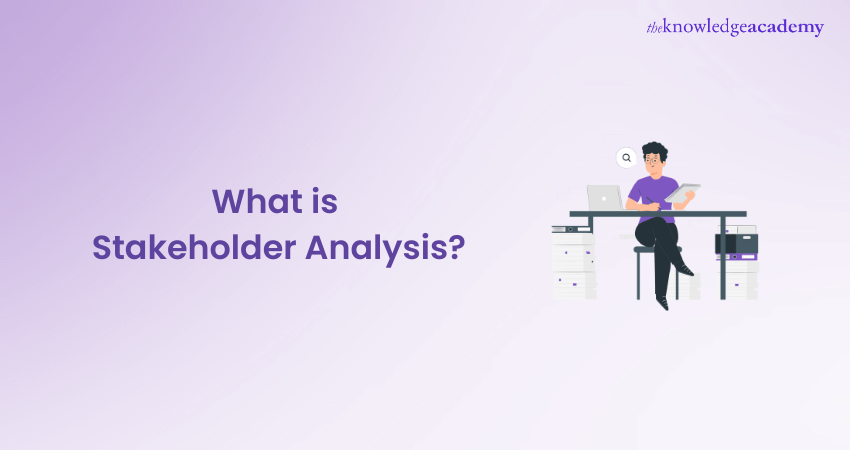
Achieving successful business outcomes may not have shortcuts, but there’s a secret ingredient that can smooth the path to project success: Stakeholder Analysis. This essential process acts as a beacon for Project Managers, guiding them through the intricate corporate landscape by identifying key players, understanding their interests, and determining the best engagement strategies.
For any aspiring Project Manager, mastering Stakeholder Analysis is crucial. It enhances transparency, builds strong relationships, manages expectations, and resolves conflicts, all while promoting informed decision-making about which stakeholders to engage with. This comprehensive blog sheds light on What is Stakeholder Analysis by exploring its purpose, benefits, tools and more. Read on!
Table of contents
1) Understanding What is Stakeholder Analysis?
2) What's the Purpose of a Stakeholder Analysis?
3) Main Benefits of Stakeholder Analysis
4) When Should you Perform the Stakeholder Analysis?
5) How do you Conduct a Stakeholder Analysis?
6) Stakeholder Analysis tools
7) Examples of Stakeholders Analysis
8) Conclusion
Understanding What is Stakeholder Analysis?
Stakeholder Analysis is a systematic procedure used in Project Management, business, and various fields in order to identify and understand the individuals, groups, or organisations that show interest in a project, decision or initiative. The Stakeholders can be internal or external to the organisation or a project. Stakeholder Analysis helps assess their needs, expectations, and interests and helps build strategies to manage and engage these stakeholders effectively.

What's the Purpose of a Stakeholder Analysis?
Project Managers may conduct a Stakeholder Analysis for several strategic reasons. Three of the biggest reasons for conducting this Analysis include:
To Enlist the Help of Major Organisational Players
By approaching company executives, influencers, or other valuable stakeholders for help early in the project, you can leverage these key players' knowledge and wisdom to drive the project to a successful outcome.
Additionally, enlisting these players early on will increase your chances of earning their support for your project. Conducting a Stakeholder Analysis will help you determine which influencers and other key stakeholders to approach.
To Achieve Early Alignment Among all Stakeholders on Goals and Plans
Once you determine which people to involve in the project, the next step is to bring these people together for early-stage meetings to communicate the project’s strategic plans and objectives.
A Stakeholder Analysis will help ensure that everyone starts the project with a clarity of what success will look like and what their contribution to that outcome should be.
To Help Address Conflicts or Issues Early on
Without a Stakeholder Analysis, your team might go far into a project before discovering that a key person doesn't see its value or wants to reallocate resources elsewhere. Such an individual could actively undermine your project. Conducting a Stakeholder Analysis beforehand would likely have identified this executive as crucial to your project's success.
Want to know how Stakeholders can drive your project’s success? Sign up for our Creating Effective Stakeholder Engagement Course now!
Main Benefits of Stakeholder Analysis
Stakeholder Analysis provides several key advantages that organisations can leverage to enhance their operations and achieve success. So, let’s have a quick look at these benefits:
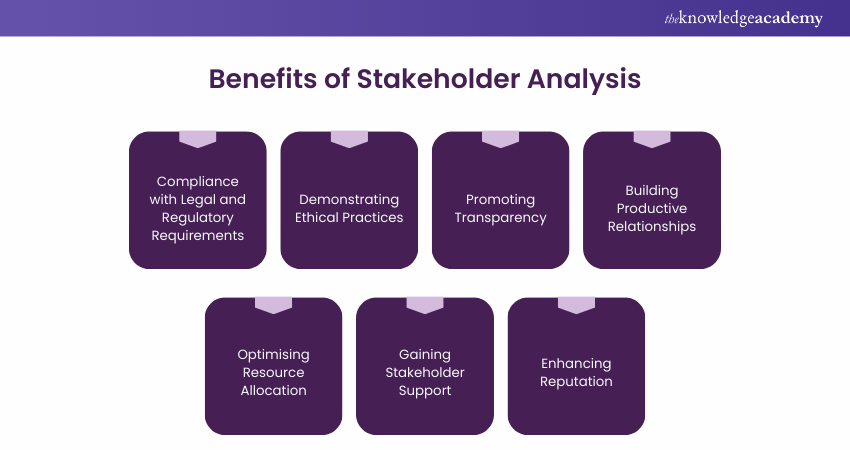
1) Understanding Stakeholder Interests and Expectations: Conducting Stakeholder Analysis enables organisations to gain valuable insights into the interests, concerns, and expectations of different Stakeholders. This understanding empowers organisations to proactively address potential issues and align project goals with Stakeholder expectations, fostering a more harmonious and cooperative relationship.
2) Managing Stakeholder Risk: Through Stakeholder Analysis, organisations can identify potential objections, conflicts, or risks associated with Stakeholders. By recognising and understanding these risks, organisations can develop effective strategies to mitigate or manage them, minimising potential disruptions and maximising project success.
3) Gaining Stakeholder Support: One of the primary benefits of Stakeholder Analysis is the ability to identify and address the concerns and interests of key stakeholders. By actively considering and responding to these concerns, organisations can cultivate Stakeholder support, which is crucial for the smooth implementation of projects or strategies.
4) Making Informed Decisions: Stakeholder Analysis ensures that decisions are not made in isolation. By considering diverse perspectives and concerns, organisations can make more informed, holistic, and sustainable decisions. This comprehensive decision-making process takes into account the needs and expectations of various Stakeholders, leading to better outcomes.
5) Optimising Resource Allocation: Understanding which Stakeholders hold the most influence or have the greatest interest in a project enables organisations to prioritise the allocation of resources such as time, money, and communication efforts. This targeted resource allocation ensures that resources are utilised efficiently and effectively, maximising project efficiency and success.
6) Building Productive Relationships: Regular engagement with Stakeholders builds trust and fosters long-term relationships. These relationships are mutually beneficial, facilitating collaboration, support, and a deeper understanding between organisations and Stakeholders. Strong relationships contribute to the overall success of current and future endeavours.
7) Promoting Transparency: Engaging Stakeholders in the decision-making process promotes transparency within organisations. This openness enhances the legitimacy and acceptance of decisions or projects, as Stakeholders feel included and informed. Transparent practices contribute to stronger relationships, increased trust, and improved project outcomes.
8) Demonstrating Ethical Practices: Considering the interests and impacts on those affected by a decision or project is an ethical imperative. Stakeholder Analysis ensures that organisations uphold ethical standards by recognising and addressing the concerns of Stakeholders. Ignoring stakeholders can lead to negative social, environmental, or economic consequences, which can tarnish an organisation's reputation.
9) Compliance with Legal and Regulatory Requirements: Engagement with Stakeholders may be a legal or regulatory requirement in certain sectors or regions. Failing to engage can result in legal complications, penalties, or project delays. Conducting stakeholder analysis helps organisations comply with these requirements, ensuring legal and regulatory adherence.
10) Improving Project Outcomes: Projects that take into account Stakeholder interests are more likely to succeed. By incorporating diverse perspectives and considering potential challenges in advance, organisations can shape projects with a broader perspective and increase the likelihood of achieving desired outcomes.
11) Enhancing Reputation: Demonstrating a commitment to valuing and responding to Stakeholder input can significantly enhance an organisation's reputation. By actively engaging Stakeholders and incorporating their feedback, organisations foster increased trust, credibility, and positive perceptions, which can lead to long-term success and opportunities.
If you want to enhance your skillset as a Project Manager, register for our Project Management Certification Course now!
When Should you Perform the Stakeholder Analysis?
The following are the key points in the project timeline where Stakeholder Analysis is particularly important:
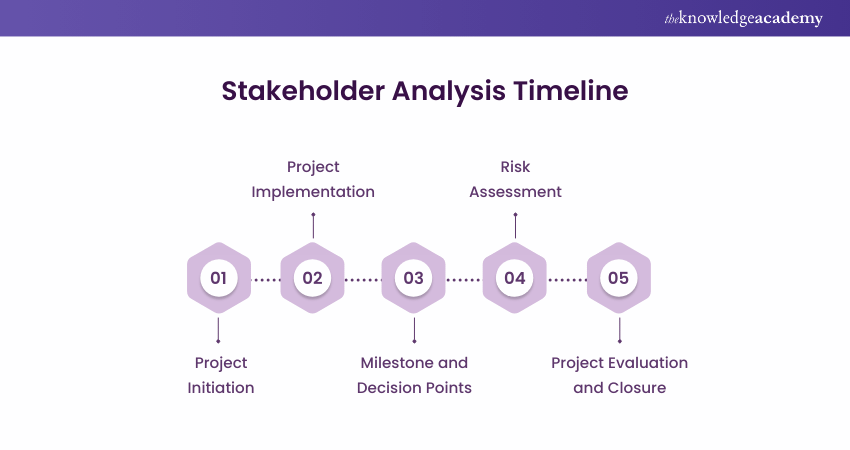
1) Project Initiation: At the inception of the project, it's very important to perform an initial Stakeholder Analysis to identify the main individual with an interest or an influence on the project. This helps in understanding the project’s political and social context, which can ultimately affect the planning of the project and decision-making.
2) Project Implementation: Throughout the project execution phase, it is essential to perform a Stakeholder Analysis. Stakeholders’ interests and influence may change over time, so it's vital to keep the analysis up to date. Actively engage with Stakeholders as per the engagement plan, ensuring their concerns are addressed, and they are well-informed.
3) Milestone and Decision Points: At significant project milestones or decision points, it’s crucial to conduct a focused Stakeholder Analysis to make sure that the right Stakeholders are engaged, and their interests are considered in the process of decision-making.
4) Risk Assessment: When dealing with project risks or issues, perform a targeted Stakeholder Analysis to identify those who may be affected by or influential in resolving the problem. Engage these Stakeholders to mitigate risks and find solutions.
5) Project Evaluation and Closure: Upon completion of the project, conduct a final Stakeholder Analysis to assess the project's overall impact on Stakeholders. Gather feedback and lessons learned from Stakeholders to inform future projects and improve Stakeholder engagement.
How do you Conduct a Stakeholder Analysis?
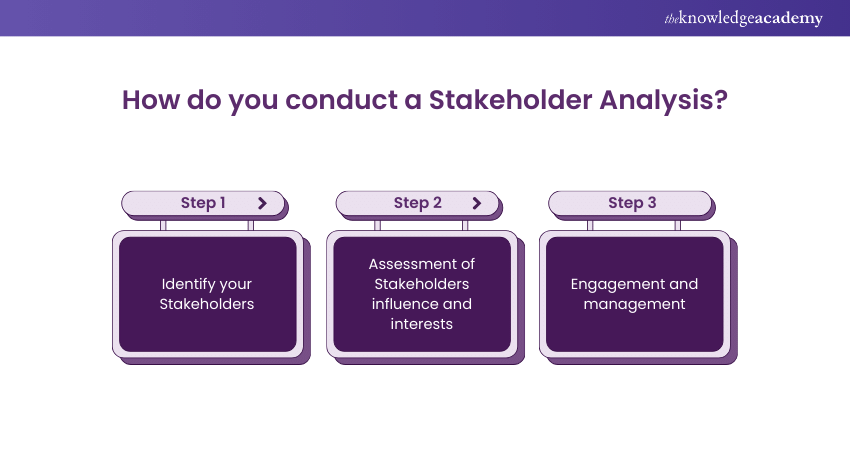
There are three steps involved in conducting the Stakeholder Analysis. Let’s understand the process of performing Stakeholder Analysis:
Identify Your Stakeholders
In this first step, you must identify who is your Stakeholder. All you need to do is enlist the number of people who are affected by your work or the people who are interested in its failure or success. Some of the people may include advisors, teammates, investors or even family members. There are two main Stakeholder groups:
Internal Stakeholders are the groups or an individuals within the business, like your leadership or team members. In contrast, External Stakeholders are groups or an individuals outside the business, including investors, customers and end-users. You are required to identify both the Stakeholders during your analysis. There are some common sources for Stakeholder identification, including the following:
a) Project documentation
b) Organisational charts
c) Previous project experience
d) Public records
e) Brainstorming sessions
Assessment of Stakeholders Influence and Interests
After identifying Stakeholders, the next step is assessing their level of interest and influence on the project or decision. In this step, you need to understand the following:
1) Interest: How much of a stake do they have in the outcome? Are they highly interested, less interested or not interested at all?
2) Influence: At what level can they impact the project or decision?
Stakeholders are often plotted on a power-interested grid which helps classify them into the following:
1) High Power, High Interest: Stakeholders need a high level of attention as they have the ability to both influence and maximise interest in the outcomes.
2) High power, Low Interest: While these Stakeholders have a high rate of influence, their interest is very low. These Stakeholders are required to be informed but not overburdened.
3) Low power, High Interest: These Stakeholders have a significant interest but hold limited influence. They must be kept informed and involved.
4) Low Power, Low Interest: As these Stakeholders hold very low interest and influence, they require very minimal attention.
Learn about the Project Manager's role and responsibilities with our Certified Global Project Manager (CGPM) Course now!
Engagement and Management
Once the Stakeholders' interests and influence have been identified, the final step requires developing a plan and managing these Stakeholders effectively. In this step, you need to tailor your approach for each Stakeholder on the power-interest grid. Consider the following, for example:
1) High-power, high-interest Stakeholders may require direct involvement, regular communication, and even collaboration.
2) High-power, low-interest Stakeholders should be kept informed with concise updates.
3) Low-power, high-interest Stakeholders can be consulted on specific issues.
4) Low-power, low-interest Stakeholders may receive minimal communication.
You need to develop a strategy for each Stakeholder including how and when to communicate with them, how to address their concerns or how to leverage their support and mitigate potential opposition. Additionally, you are required to review and update the Stakeholder Analysis throughout the project and decision-making process.
Stakeholder Analysis Tools
Stakeholder Analysis tools provide a range of options for conducting effective Stakeholder Management activities. While traditional methods such as pen and paper or sticky notes can be used, specialised software products are now available that streamline and automate the process. These tools offer various features and functionalities to enhance Stakeholder Analysis. Let’s explore them below:
1) Tractivity: This tool offers an intuitive mapping tool, a survey builder, and a comprehensive engagement platform. This software enables you to visualise Stakeholder relationships, gather feedback through surveys, and effectively engage with stakeholders throughout the project.
2) Simply Stakeholders: This tool provides task management capabilities along with an AI-driven sentiment analysis feature. This allows you to track and manage tasks related to Stakeholder Management while also gaining insights into your stakeholders' sentiments and opinions.
3) Syrenis: This is another software solution that offers robust planning and engagement support. With this tool, you can effectively plan your Stakeholder engagement activities, manage interactions, and monitor the progress of your stakeholder relationships.
4) Borealis: This is a Stakeholder Analysis tool that stands out for its neat reporting capabilities. It enables you to generate comprehensive reports on stakeholder engagement activities, track key metrics, and provide valuable insights to managers and decision-makers.
By utilising these specialised tools, you can centralise stakeholder-related data, perform Sentiment Analysis, foster team collaboration, and gain a holistic view of Stakeholder dynamics throughout the project lifecycle. In addition, these tools enable you to create essential Stakeholder Management deliverables, document interactions, and generate reports to support effective decision-making.
Examples of Stakeholders Analysis
Conducting a Stakeholder Analysis before project Execution helps Project Managers identify and address any misconceptions or potential opposition that may arise. While there are various approaches to conducting a comprehensive Stakeholder Analysis, one effective method involves plotting the analysis on a graph.
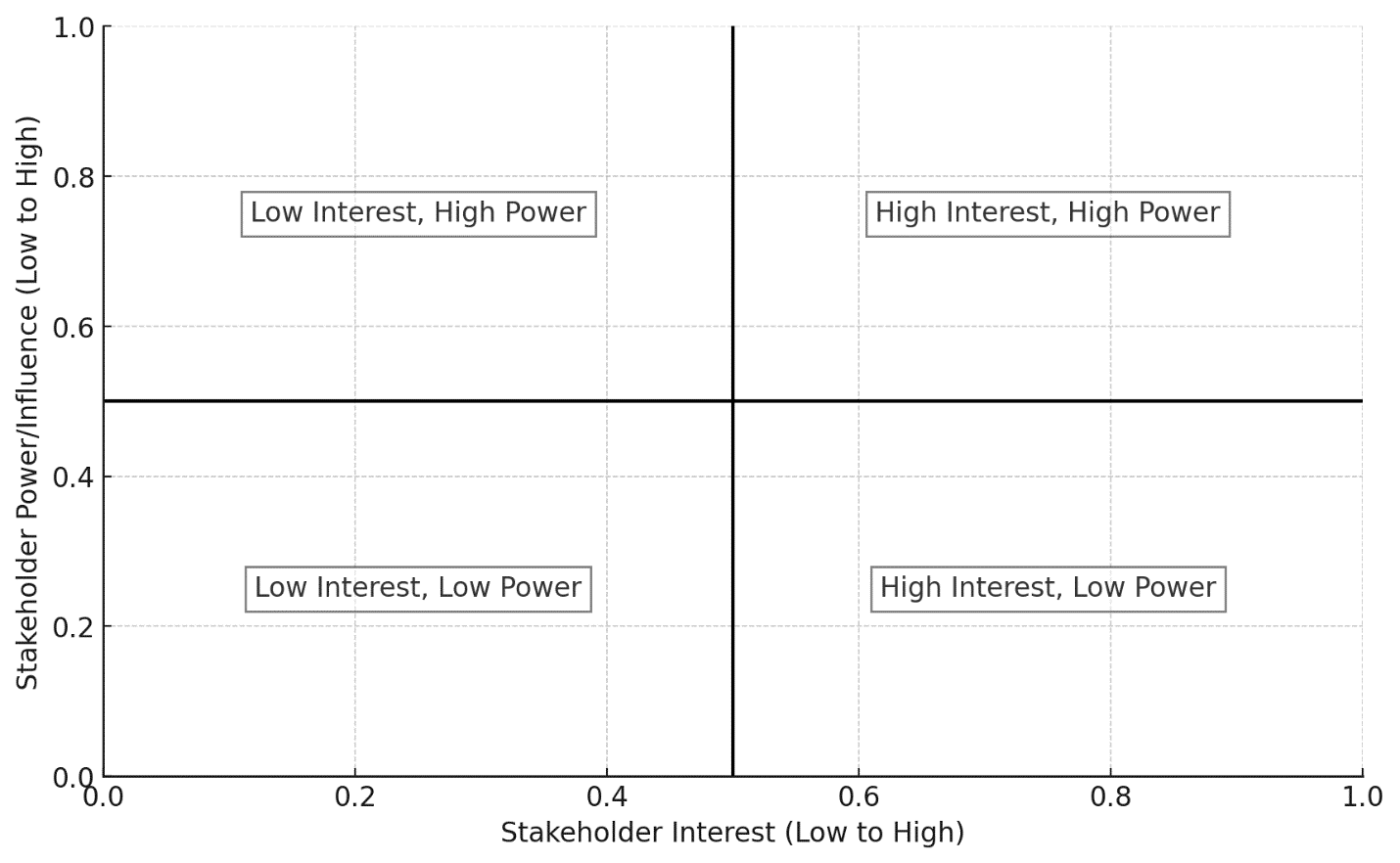
1) To begin, Project Managers can use the X-axis to represent the range of Stakeholder interest, from low to high.
2) Conversely, the Y-axis can represent the level of power or influence held by stakeholders, ranging from low to high.
3) By dividing the graph into four quadrants, each quadrant can be labelled as "Low Interest, Low Power," "High Interest, High Power," "High Interest, Low Power," and "Low Interest, High Power."
This visual representation provides valuable insights into the level of communication and engagement required for each Stakeholder or Stakeholder group. It helps Project Managers prioritise their efforts and tailor their communication strategies accordingly, ensuring effective Stakeholder engagement throughout the project lifecycle.
Join our Project Management Office Green Belt Course now and gain a comprehensive understanding of managing Stakeholders!
Conclusion
Conducting a Stakeholder Analysis is extremely crucial as it is a key factor in deciding how smoothly a project can be conducted and how well it is expected to achieve outcomes. By leveraging effective processes and tools, you can ensure robust communication, address concerns, and foster collaboration with stakeholders. We hope this blog helps you gain deeper insight into What is Stakeholder Analysis and boost your projects towards success and excellence.
Get familiar with the financial sustainability of an infrastructure project by joining our Project And Infrastructure Financing Training now!
Frequently Asked Questions

According to the Chartered Institute of Personnel and Development (CIPD), Stakeholder analysis is the process of analysing various stakeholders' influence on a business.

A manager would perform a Stakeholder Analysis to outline the key stakeholders and their needs for the project. Understanding each stakeholder clearly and what they expect from the project from the start is essential.

The Knowledge Academy takes global learning to new heights, offering over 30,000 online courses across 490+ locations in 220 countries. This expansive reach ensures accessibility and convenience for learners worldwide.
Alongside our diverse Online Course Catalogue, encompassing 17 major categories, we go the extra mile by providing a plethora of free educational Online Resources like News updates, Blogs, videos, webinars, and interview questions. Tailoring learning experiences further, professionals can maximise value with customisable Course Bundles of TKA.

The Knowledge Academy’s Knowledge Pass, a prepaid voucher, adds another layer of flexibility, allowing course bookings over a 12-month period. Join us on a journey where education knows no bounds.

The Knowledge Academy offers various Project Management Courses, including Certified Digital Services Project Manager Course, Certified Global Project Manager Training, and Project Management Office Fundamentals Certification Course. These courses cater to different skill levels, providing comprehensive insights into Project Management methodologies.
Our Project Management Blogs cover a range of topics related to PRINCE2, offering valuable resources, best practices, and industry insights. Whether you are a beginner or looking to advance your Project Management skills, The Knowledge Academy's diverse courses and informative blogs have you covered.
Upcoming Project Management Resources Batches & Dates
Date
 Introduction to Project Management Course
Introduction to Project Management Course
Thu 1st Jan 1970







 Top Rated Course
Top Rated Course


 If you wish to make any changes to your course, please
If you wish to make any changes to your course, please


